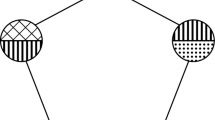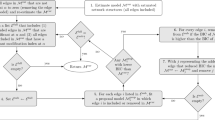Abstract
Among bivariate tail dependence measures, the tail dependence coefficient has emerged as the popular choice. Akin to the correlation matrix, a multivariate dependence measure is constructed using these bivariate measures, and this is referred to in the literature as the tail dependence matrix (TDM). While the problem of determining whether a given d × d matrix is a correlation matrix is of the order O(d3) in complexity, determining if a matrix is a TDM (the realization problem) is believed to be non-polynomial in complexity. Using a linear programming (LP) formulation, we show that the combinatorial structure of the constraints is related to the intractable max-cut problem in a weighted graph. This connection provides an avenue for constructing parametric classes admitting a polynomial in d algorithm for determining membership in its constraint polytope. The complexity of the general realization problem is justifiably of much theoretical interest. Since in practice one resorts to lower dimensional parametrization of the TDMs, we posit that it is rather the complexity of the realization problem restricted to parametric classes of TDMs, and algorithms for it, that are more practically relevant. In this paper, we show how the inherent symmetry and sparsity in a parametrization can be exploited to achieve a significant reduction in the LP formulation, which can lead to polynomial complexity of such realization problems - some parametrizations even resulting in the constraint polytope being independent of d. We also explore the use of a probabilistic viewpoint on TDMs to derive the constraint polytopes.
Similar content being viewed by others
References
Babai, L.: Graph Isomorphism in Quasipolynomial Time. arXiv e-prints, art. arXiv:1512.03547v2 (2015)
Barahona, F.: The max-cut problem on graphs not contractible to k5. Oper. Res. Lett. 2(3), 107–111 (1983)
Barber, C.B., Dobkin, D.P., Huhdanpaa, H.: The quickhull algorithm for convex hulls. ACM Trans. Math. Softw. 22(4), 469–483 (1996). https://doi.org/10.1145/235815.235821
Benham, T.: Uniform distribution over a convex polytope. https://www.mathworks.com/matlabcentral/fileexchange/34208-uniform-distribution-over-a-convex-polytope, MATLAB Central File Exchange. Retrieved Feb 13 2012 (2011)
Chaganty, N.R., Joe, H.: Range of correlation matrices for dependent Bernoulli random variables. Biometrika 93(1), 197–206 (2006). https://doi.org/10.1093/biomet/93.1.197
Deza, M.M., Laurent, M.: Geometry of cuts and metrics, Algorithms and Combinatorics, vol. 15. Springer, Heidelberg. https://doi.org/10.1007/978-3-642-04295-9, first softcover printing of the 1997 original [MR1460488] (2010)
Edmonds, J.: Maximum matching and a polyhedron with 0,1-vertices. J. Res. Nat. Bur. Stand. Sect B 69B, 125–130 (1965)
Embrechts, P., Hofert, M., Wang, R.: Bernoulli and tail-dependence compatibility. Ann. Appl. Probab. 26(3), 1636–1658 (2016). https://doi.org/10.1214/15-AAP1128
Falk, M.: On the generation of a multivariate extreme value distribution with prescribed tail dependence parameter matrix. Statist. Probab. Lett. 75(4), 307–314 (2005). https://doi.org/10.1016/j.spl.2005.06.007
Fiebig, U.R., Strokorb, K., Schlather, M.: The realization problem for tail correlation functions. Extremes 20(1), 121–168 (2017). https://doi.org/10.1007/s10687-016-0250-8
Garey, M.R., Johnson, D.S.: Computers and Intractability. W. H. Freeman and Co. San Francisco, Calif., a guide to the theory of NP-completeness. A Series of Books in the Mathematical Sciences (1979)
Gawrilow, E., Joswig, M.: Polymake: a Framework for Analyzing Convex Polytopes. In: Polytopes—Combinatorics and Computation (Oberwolfach, 1997), DMV Sem., Vol 29, pp. 43–73. Birkhäuser, Basel (2000)
Grötschel, M., Lovász, L., Schrijver, A.: Geometric Algorithms and Combinatorial Optimization, Algorithms and Combinatorics, 2nd edn., vol. 2. Springer, Berlin (1993). https://doi.org/10.1007/978-3-642-78240-4
Hammer, P.L., Rubin, A.A.: Some remarks on quadratic programming with 0 − 1 variables. Rev. Franç. Inform. Recherch. Opér. 4(Sér. V-3), 67–79 (1970)
Kaibel, V., Weltge, S.: A short proof that the extension complexity of the correlation polytope grows exponentially. Discret. Comput. Geom. 53(2), 397–401 (2015)
Kapoor, S., Vaidya, P.M.: Fast algorithms for convex quadratic programming and multicommodity flows. In: Proceedings of the eighteenth annual ACM symposium on Theory of computing, pp. 147–159. ACM (1986)
Karp, R.M.: Reducibility among combinatorial problems. Complexity of computer computations. P,roc Sympos, IBM Thomas J Watson Res Center, pp. 85–103. Yorktown Heights, NY (1972)
Khachiyan, L.G.: A polynomial algorithm in linear programming. Dokl. Akad. Nauk. SSSR 244(5), 1093–1096 (1979)
Kortschak, D., Albrecher, H.: Asymptotic results for the sum of dependent non-identically distributed random variables. Methodol. Comput. Appl. Probab. 11 (3), 279–306 (2009). https://doi.org/10.1007/s11009-007-9053-3
Kozlov, M.K., Tarasov, S.P., Hačijan, L.G.: Polynomial solvability of convex quadratic programming. Dokl. Akad. Nauk. SSSR 248(5), 1049–1051 (1979)
Krause, D., Scherer, M.: Bernoulli and tail-dependence matrices: A simple numerical test. Working Paper. https://mediatum.ub.tum.de/doc/1285465/1285465.pdf (2015)
Krause, D., Scherer, M., Schwinn, J., Werner, R.: Membership testing for Bernoulli and tail-dependence matrices. Working Paper. https://mediatum.ub.tum.de/doc/1378029/1378029.pdf (2017)
Krause, D., Scherer, M., Schwinn, J., Werner, R.: Membership testing for Bernoulli and tail-dependence matrices. J. Multivar. Anal. 168, 240–260 (2018). https://doi.org/10.1016/j.jmva.2018.07.014
Lee, A.: Generating random binary deviates having fixed marginal distributions and specified degrees of association. Am. Stat. 47(3), 209–215 (1993)
Lübbecke, M.E.: Column generation. Wiley Encyclopedia of Operations Research and Management Science. https://doi.org/10.1002/9780470400531.eorms0158 (2010)
Mathon, R.: A note on the graph isomorphism counting problem, vol. 8. ISSN 0020-0190. https://doi.org/10.1016/0020-0190(79)90004-8 (1979)
McKay, B.D., Piperno, A.: Practical graph isomorphism. II. J. Symbol. Comput. 60, 94–112 (2014). ISSN 0747-7171. https://doi.org/10.1016/j.jsc.2013.09.003
Padberg, M.: The Boolean quadric polytope: some characteristics, facets and relatives. Math. Programm. 45(1-3), 139–172 (1989)
Pardalos, P.M., Vavasis, S.A.: Quadratic programming with one negative eigenvalue is NP-hard. J. Glob. Optim. 1(1), 15–22 (1991). https://doi.org/10.1007/BF00120662
Pitowsky, I.: Correlation polytopes: their geometry and complexity. Math Programm. 50(3, (Ser. A)), 395–414 (1991). https://doi.org/10.1007/BF01594946
Sahni, S.: Computationally related problems. SIAM J. Comput. 3, 262–279 (1974). https://doi.org/10.1137/0203021
The Sage Developers: SageMath, the Sage Mathematics Software System (Version 8.8). https://www.sagemath.org (2019)
Shih, W.K., Wu, S., Kuo, Y.S.: Unifying maximum cut and minimum cut of a planar graph. IEEE Trans. Comput. 39(5), 694–697 (1990). https://doi.org/10.1109/12.53581
Strokorb, K.: Characterization and construction of max-stable processes. PhD thesis. http://hdl.handle.net/11858/00-1735-0000-0001-BB44-9 (2013)
Vaidya, P.M.: Speeding-up linear programming using fast matrix multiplication. In: 30th Annual Symposium on Foundations of Computer Science, pp. 332–337 (1989)
Vanderbei, R.J.: Linear Programming, International Series in Operations Research & Management Science, 4th edn., vol. 196. Springer, New York (2014). https://doi.org/10.1007/978-1-4614-7630-6
Xu, S.: The line index and minimum cut of weighted graphs. Eur. J. Oper. Res. 109(3), 672–685 (1998)
Ye, Y., Tse, E.: An extension of Karmarkar’s projective algorithm for convex quadratic programming. Math. Programm. 44(1-3), 157–179 (1989)
Zhang, Z.: A New Class of Tail-Dependent Time-Series Models and Its Applications in Financial Time Series. In: Econometric Analysis of Financial and Economic Time Series. Part B, Adv. Econom, vol. 20, pp. 317–352. Emerald/JAI, Bingley (2008)
Acknowledgements
Our interest in the realization problem arose from discussions with Paul Embrechts, to whom we owe a debt of gratitude. We thank an associate editor for bringing our attention to Krause et al. (2017), and an area editor and two referees for many thoughtful suggestions. We thank Jonas Schwinn and Ralf Werner for graciously sharing their well executed implementation of the KSSW algorithm without which parts of this work would not have been possible. Also, we would like to thank Sam Burer and Ruodu Wang for fruitful discussions. The first author would like to acknowledge with gratitude the support from a Society of Actuaries’ Center of Actuarial Excellence Research Grant.
Author information
Authors and Affiliations
Corresponding author
Additional information
Publisher’s note
Springer Nature remains neutral with regard to jurisdictional claims in published maps and institutional affiliations.
A Appendix
A Appendix
Rights and permissions
About this article
Cite this article
Shyamalkumar, N.D., Tao, S. On tail dependence matrices. Extremes 23, 245–285 (2020). https://doi.org/10.1007/s10687-019-00366-y
Received:
Revised:
Accepted:
Published:
Issue Date:
DOI: https://doi.org/10.1007/s10687-019-00366-y










